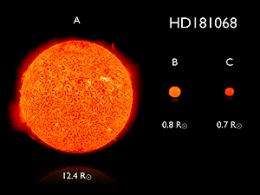Astronomers discover Kepler's trinity

NASA's revolutionary Kepler satellite has discovered a unique triply eclipsing triple star, reports an international team of astronomers.
The group's discovery of a unique stellar system was published in today's Science magazine.
The object, catalogued as HD 181068 and nicknamed `Trinity' by the research team, and is a seventh magnitude star that is almost visible to the naked eye.
University of Sydney astronomer Daniel Huber from the School of Physics says: "We found what was a seemingly single star is in reality a complex triple system in which three stars reside in a very special geometry.
The observations we have show mutual eclipses as each of the stars gets behind or in front of the others. The most luminous object is a red giant star around which a close pair of two red dwarfs orbits with a period of 45.5 days."
Lead author on the paper Aliz Derekas from the Eotvos University and Konkoly observatory, Budapest, Hungary says: "Thanks to the fortunate viewing angle from Earth, the combined light from the three stars change very characteristically. There are sharp brightness decreases with a period of 0.9 days produced by the mutual eclipses of the close pair of dwarfs, while it takes two days for the close pair to pass in front of or behind the red giant.
"A mind-boggling feature of the variations is that when the red dwarfs are in front of the red giant, their short-period eclipses disappear.
This is because the surface brightness of the three stars are actually very similar, and just as a white rabbit cannot be seen in snow-fall, the red dwarfs in front of the red giant are also almost invisible, hence no light is lost when they eclipse each other."
Huber who led the interferometric observations using the Center for High-Angular Resolution Astronomy (CHARA) at Mount Wilson Observatory in California, USA says further observations using interferometry were used to measure the angular size of the red giant.
"Combining the angular diameter with the known distance of the system we were able to measure the absolute radius of the red giant, which was a great achievement given its large distance of 800 light years," states Huber.
The results show that the largest star in the system is 12.4 times larger than our Sun. The scientists could also estimate the mass of the main component as 3 times that of the Sun.
The discovery of this complex system is significant because HD 181068 is a real astrophysical labaratory where changes in the orbital elements can be detected in a few years from now.
In addition, HD 181068 has further peculiar features. Careful analyses of other red giant stars observed by Kepler have shown that all red giant stars should exhibit oscillations similar to those in the Sun.
"The frequency of these oscillations can be theoretically determined knowing the basic physical parameters of the red giant, their mass, temperature, and radius.
"However, there is no sign of such oscillations in the red giant component of HD 181068 which means there must be a mysterious mechanism that suppresses the pulsation.
"Surprisingly, we do detect some variability but with periods that are closely linked to the orbital period of the close pair in the system," states Dr. Derekas. This may indicate that tidal forces of the close pair induce vibes in the surface of the red giant.
More information:
HD 181068: A Red Giant in a Triply Eclipsing Compact Hierarchical Triple System, Derekas, et al. Science 8 April 2011: 216-218.
DOI:10.1126/science.1201762
Provided by University of Sydney

















